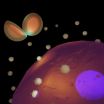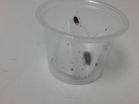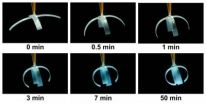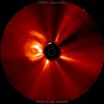(Press-News.org) WASHINGTON, Nov. 20, 2012 — The American Chemical Society (ACS) today launched a new video series that highlights headline-making research from the society's suite of more than 40 peer-reviewed scientific journals. The first episode of Breakthrough Science focuses on research reported in one of those journals, ACS Nano. It involved development of new transparent solar cells, an advance toward giving windows in homes and other buildings the ability to generate electricity while still allowing people to see outside.
The video is available at http://pubs.acs.org/page/videos/breakthroughscience.html.
Breakthrough Science features newsworthy research with the potential to improve everyday life. The series includes interviews with scientists from a range of fields, complemented by engaging graphics and animation. New episodes will be released on a regular basis.
In the video, Yang Yang, Ph.D., of the University of California, Los Angeles, explains the development of a new kind of solar cell that produces energy by absorbing mainly infrared light, not visible light, making the cells 66 percent transparent. These so-called polymer solar cells are lightweight and flexible and can be produced in high volume at low cost.
Yang and co-author Paul S. Weiss, Ph.D., a UCLA professor who also is editor-in-chief of ACS Nano, explain how they made the device from a photoactive plastic that converts infrared light into an electrical current. They predict that the technology could be used on buildings within a few years.
Yang and Weiss are also the focus of the film Catching the Invisible Light, a semifinalist in the Focus Forward Filmmaker Competition. Finalists will be shown at the Sundance Film Festival, and the top award will receive a $100,000 Grand Prize.
###
The American Chemical Society is a nonprofit organization chartered by the U.S. Congress. With more than 164,000 members, ACS is the world's largest scientific society and a global leader in providing access to chemistry-related research through its multiple databases, peer-reviewed journals and scientific conferences. Its main offices are in Washington, D.C., and Columbus, Ohio.
To automatically receive news releases from the American Chemical Society, contact newsroom@acs.org.
Follow us: Twitter | Facebook
New American Chemical Society video series shines a light on transparent solar cells
2012-11-21
ELSE PRESS RELEASES FROM THIS DATE:
Researchers find decline in availability and use of key treatment for depression
2012-11-21
Providence, RI - - Electroconvulsive therapy (ECT) is considered the most effective treatment option for patients with severe depression who cannot find symptom relief through antidepressant medications or psychotherapy. In a new study, researchers at Butler Hospital and Bradley Hospital in Rhode Island found a sharp decline in the availability and use of ECT in general hospitals across the U.S. The findings were published online in the journal Biological Psychiatry on October 10, 2012.
The researchers analyzed data from a nationally representative survey of US general ...
New method helps target Parkinson's disease
2012-11-21
Health professionals may soon have a new method of diagnosing Parkinson's disease, one that is noninvasive and inexpensive, and, in early testing, has proved to be effective more than 90 percent of the time.
In addition, this new method has the potential to track the progression of Parkinson's, as well as measure the effectiveness of treatments for the disorder, said Rahul Shrivastav, professor and chairperson of Michigan State University's Department of Communicative Sciences and Disorders and a member of the team developing the new method.
It involves monitoring a ...
Tiny probes shine brightly to reveal the location of targeted tissues
2012-11-21
Called BRIGHTs, the tiny probes described in the online issue of Advanced Materials on Nov. 15, bind to biomarkers of disease and, when swept by an infrared laser, light up to reveal their location.
Tiny as they are, the probes are exquisitely engineered objects: gold nanoparticles covered with molecules called Raman reporters, in turn covered by a thin shell of gold that spontaneously forms a dodecahedron.
The Raman reporters are molecules whose jiggling atoms respond to a probe laser by scattering light at characteristic wavelengths.
The shell and core create an ...
IUDs don't cause pelvic inflammatory disease in women
2012-11-21
The risk of developing pelvic inflammatory disease (PID) following insertion of an intrauterine device (IUD) is very low, whether or not women have been screened beforehand for gonorrhea and chlamydia, according to a joint study of nearly 60,000 women by researchers at the University of California, San Francisco (UCSF), and Kaiser Permanente Northern California Division of Research.
The study appears this week in the current online issue of Obstetrics & Gynecology, the official journal of the American College of Obstetricians and Gynecologists, also known as Green Journal.
The ...
New electrically-conductive polymer nanoparticles can generate heat to kill colorectal cancer cells
2012-11-21
WINSTON-SALEM, N.C., – Nov. 20, 2012 – Researchers at Wake Forest Baptist Medical Center have modified electrically-conductive polymers, commonly used in solar energy applications, to develop revolutionary polymer nanoparticles (PNs) for a medical application. When the nanoparticles are exposed to infrared light, they generate heat that can be used to kill colorectal cancer cells.
The study was directed by Assistant Professor of Plastic and Reconstructive Surgery, Nicole H. Levi-Polyachenko, Ph.D., and done in collaboration with colleagues at the Center for Nanotechnology ...
Natural fungus may provide effective bed bug control
2012-11-21
UNIVERSITY PARK, Pa. -- "And don't let the bed bugs bite" is no longer a harmless adage. In reality today, these bloodthirsty bugs infest thousands of homes. According to a team of Penn State entomologists, biopesticides -- naturally occurring microorganisms -- might provide an answer to this pest problem.
Bed bugs need blood meals for growth and development throughout their life cycle. Increased travel, widespread insecticide resistance and changes in management practices have caused a resurgence in those insects throughout North America and Europe. Compounding the problem ...
Scotch tape finds new use as grasping 'smart material'
2012-11-21
WEST LAFAYETTE, Ind. – Scotch tape, a versatile household staple and a mainstay of holiday gift-wrapping, may have a new scientific application as a shape-changing "smart material."
Researchers used a laser to form slender half-centimeter-long fingers out of the tape. When exposed to water, the four wispy fingers morph into a tiny robotic claw that captures water droplets.
The innovation could be used to collect water samples for environmental testing, said Babak Ziaie, a Purdue University professor of electrical and computer engineering and biomedical engineering.
The ...
Adenotonsillectomy may help resolve obstructive sleep apnea in children with Prader-Willi syndrome
2012-11-21
Children with Prader-Willi syndrome may receive relief from sleep disorders after undergoing an adenotonsillectomy, suggests a new study from Nationwide Children's Hospital published in the November print issue of the Archives of Otolaryngology-Head and Neck Surgery.
"Patients with Prader-Willi syndrome are at risk for sleep disordered breathing as growth hormone commonly used to treat their condition can cause the tonsils and adenoids to enlarge," said the study's lead author Kris Jatana, MD, FAAP, with Otolaryngology Head & Neck Surgery at Nationwide Children's.
"Growth ...
NASA spacecraft observe Nov. 20 solar eruption
2012-11-21
On Nov. 20, 2012, at 7:09 a.m. EST, the sun erupted with a coronal mass ejection or CME. Not to be confused with a solar flare, a CME is a solar phenomenon that can send solar particles into space and can reach Earth one to three days later. When Earth-directed, CMEs can affect electronic systems in satellites and on Earth.
Experimental NASA research models, based on observations from the Solar Terrestrial Relations Observatory (STEREO), show that the Nov. 20 CME left the sun at speeds of 450 miles per second, which is a slow to average speed for CMEs. CMEs can cause ...
MRI shows brain disruption in patients with post-concussion syndrome
2012-11-21
OAK BROOK, Ill. – MRI shows changes in the brains of people with post-concussion syndrome (PCS), according to a new study published online in the journal Radiology. Researchers hope the results point the way to improved detection and treatment for the disorder.
PCS affects approximately 20 percent to 30 percent of people who suffer mild traumatic brain injury (MTBI)—defined by the World Health Organization as a traumatic event causing brief loss of consciousness and/or transient memory dysfunction or disorientation. Symptoms of PCS include headache, poor concentration ...





